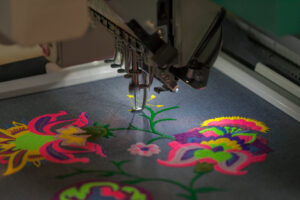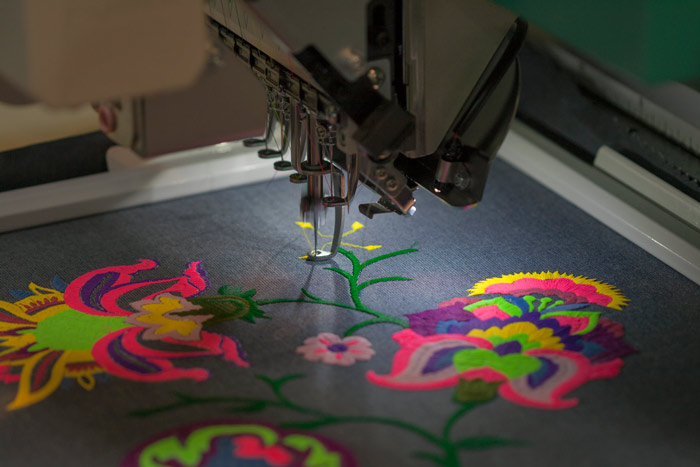 Embroidery is an art that is worth passing onto the next generation.
Embroidery is an art that is worth passing onto the next generation.
And if you’re here, I’m sure that someone ignited this passion in you as well.
I know it because that’s how it happened with me as well. But as a beginner, making progress can be quite daunting.
Don’t get me wrong; embroidery isn’t a hard skill in itself. To put it simply, it’s an art.
Crafted with perspective and individual taste, the right type of grooming and attention can make this hobby blossom.
Hence, I’ve taken the liberty of the top tips that helped me in my journey. And I’m sure they’ll help you as well. Stay tuned and check out my top 21 embroidery tips for beginners!
Here’s what you should do!
1. Always choose the right needle
The first thing that you should need is the right needle for the right job. It’s a general fact that different needles come in different shapes and sizes, which is why they’re all suited better for different tasks.
Ensure the type of embroidery you intend to do and choose the right needle to make the job easier!
2. Be versatile with stitch style
To get better and embroidery and to get there fast, it’s a good idea to always be on the lookout to learn a new style of the stitch.
If you’ve covered one base, the best way to progress is to pick up something new. Even better if you can merge different stitch styles and experiment with hybrids, leading to your new style!
3. Use thread conditioner
A pre-stitched conditioner will make your threads of better quality and will make sure that they last longer as well.
I would recommend this since it would make embroidery easier and will also help keep your threads firm and secure when you’re working with tight knots.
4. Be artsy
Flowers are a beautiful pattern that always looks well on embroidery. Hence, if you want to beautify your patterns, it’s a good idea to experiment with flowers and the wide variety that they have to offer.
5. Use negative space
Negative space embroidery means coloring outside the line! Move a little away from the traditional stroke, and the learning curve will help you speed up the process.
This is also an awesome way to experiment with personal style, which is why I would highly recommend it!
6. Forget the fabric
You don’t need to work with fabric at all times. If you want to get creative, I’d recommend getting your hands on your favorite floss colors and work your magic through them.
This will help you get an idea of what color can blend with the background better, ultimately leading to better compositional skills.
7. Utilize pop art
Pop art embroidery is a great way to reflect on what’s famous these days and what isn’t.
I suggest looking at inspirations around you and try to incorporate that into your work, even if it’s at its simplest or rudimentary form.
8. Be gentle with the process
Since embroidery does require piercing through the fabric, beginners often make the mistake of applying too much pressure.
Even though you can get results with this, this might take the fun out of the processor can even prove detrimental if you’re trying to get the details right down to the last thread.
I’d recommend being gentle and always taking your time.
9. Take a break
Embroidery can be tiring, especially if you’re working on great details.
And one mistake that people often make is committing to completing a whole task in one sitting, which is a mistake.
Make sure to set small benchmarks at which you can reward yourself. Not only will this reinforce your craft, but it will also make the process more wholesome.
10. Work in clear lighting
You cannot create what you cannot see. This sentiment applies equally well to embroidery as well.
When working with delicate fabrics and subtle coloration, it’s always a good idea to work in a well-lit place.
But make sure that the place isn’t too bright, or else you won’t be able to pick out the details carefully.
Again, this will go a long way and help you inculcate a habit that will immensely help you progress your skill.
11. Never rush
Embroidery is an art that is best fuelled by patience and love. Rushing through the process, like anything natural, can only hinder growth.
Since you won’t dedicate the proper energy and focus to the task at hand, you risk compromising learning the right lessons along the way.
Make sure to never rush when embroidering and always take your time to get things done right. Again, this is one principle that is super important for growth.
12. Be proud of what you make
Whatever you do, being proud of what you make is something that goes without saying. Remember, to be good at something; you have to suck at it initially.
And that’s fine. No one achieved greatness in a day. Whatever you make, be proud of it. Embrace the process and let it consume you whole!
13. Be wary of the back
When embroidering, make sure you pay attention to the back of the material, especially if both sides are displayed.
This is a good skill to work on, but I recommend that you experiment with this separately and start with basic patterns only. Once you master this, you can try experimenting with flowers and pop art.
Have fun!
At the end of the day, if you’re not having fun with the process, then this hobby isn’t for you.
Embroidery is one of those hobbies that is supposed to bring you closer to yourself, to help you find peace and happiness in an activity that demands your whole attention.
If you can’t find that just yet, reassess your strategies and prioritize and align them in a manner that allows you to have fun while embroidering!
14. Choose the right hoop size
I would personally recommend using a hoop size that is at least one size larger than you need for the task at hand.
This is one thing that personally works for me every time and helps me get the result I want without sacrificing any quality.
The only thing that changes is the ease with which I can work. This also makes sure that the edges of the hoop don’t get in the way.
15. Secure the thread well
Make sure to always secure the thread well. Failing to do so can halter progress and can ruin progress if the damage is irreversible or if you were working on a region that demanded a lot of attention to detail.
Get acquainted with basic knots you can tie and then use them for secure threading.
16. Take care of the traveling thread
The last thing that you want is your thread on the backside showing through the fabric in the front. This is something that frequently happens if you don’t pay attention to the traveling thread.
Make sure that after every stitch, the thread at the back is accounted for and looked after.
17. One project at a time
When starting, I would personally recommend that you only work on one project at a time.
There are several reasons for this, but the main one is that doing so would ensure that you can dedicate all your time, attention, and resources to getting the basics right on a singular task.
This will help you perfect one move before moving onto the next.
18. Don’t fool around
Needles are sharp, and anything sharp has the potential to cause injuries. When embroidering, it’s a good idea to make sure that you’re gentle with the process.
This is no space for fooling around or being clumsy since that can cause injuries or other mishaps that could have been easily avoided.
19. Trust the process
Trusting the process is easier said than done. In principle, I would recommend that you don’t let minor drawbacks or mishaps throw you back.
The only goal is to put the time in, and sooner or later, you will see results. Just make sure to be consistent with the habit, and something beautiful will come out of it soon!
Compare results!
Once you trust the process, you’ll see progress. And the best way to fuel motivation and be geared for more excellence is to track through all the work you’ve done and how much you’ve gotten better!
Conclusion
I hope that the tips mentioned above help you immensely in this journey of embroidery that enlightens us.
Plus, using them also means that you’ll be able to advance your skillset in a better place with more room for growth.
If you have any questions or queries or would like additional assistance, do share your thoughts in the comment section below!
Read Also:

